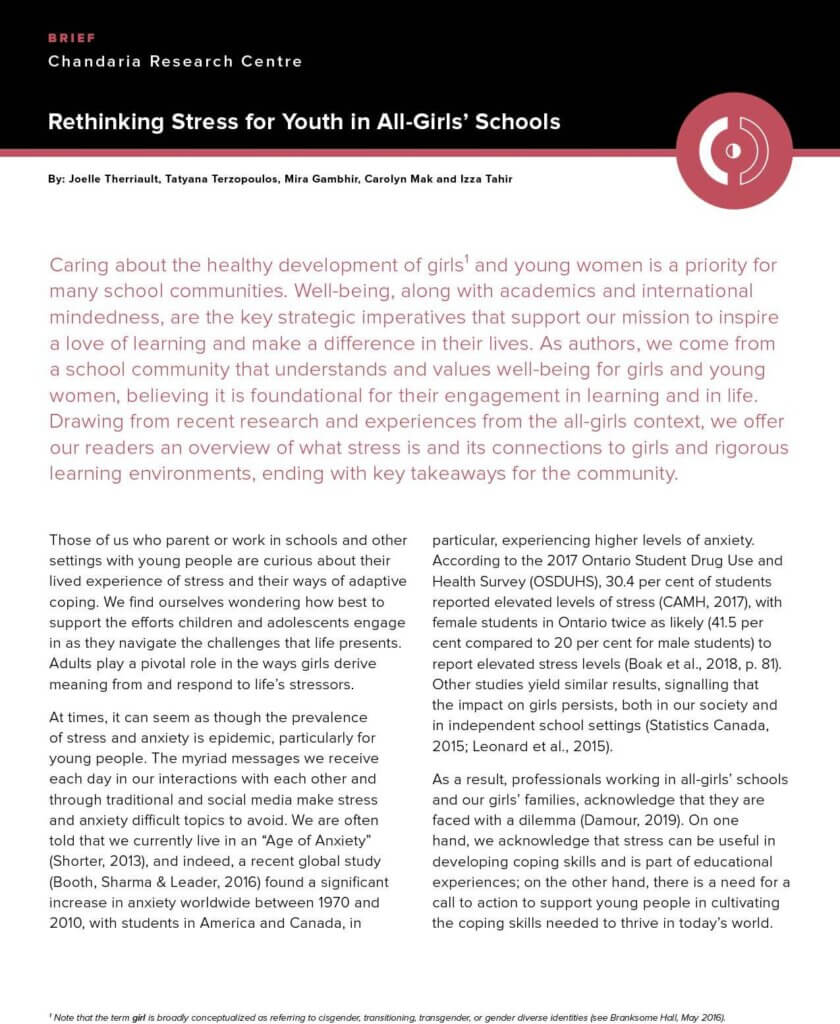Berry, J.W. (2006). Acculturative stress. InT.P. Wong & L.C.J. Wong (Eds.), Handbook of multicultural perspectives on stress and coping (pp. 287-298). New York, NY: Springer, Inc.
Björling, E. A., & Singh, N. B. (2017). Anger without agency: Exploring the experiences of stress in adolescent girls. The Qualitative Report, 22(10), 2583-2599.
Boak, A., Hamilton, H.A., Adlaf, E.M., Henderson, J.L. & Mann, R.E. (2018). The mental health and well-being of Ontario students: Detailed findings from the Ontario Student Drug Use and Health Survey. Toronto, ON: Centre for Addiction and Mental Health.
Booth, R.W., Sharma, D. & Leader, T.I. (2016). The age of anxiety? It depends on where you look: changes in STAI trait anxiety, 1970-2010. Social Psychiatry and Psychiatric Epidemiology, 51(2), 193-202.
CAMH: The Centre for Addiction and Mental Health (2017). The Ontario Student Drug Use and Health Survey (OSDUHS). Retrieved from https://www.camh.ca/en/science-and-research/institutesand-centres/institute-for-mental-health-policyresearch/ontario-student-drug-use-and-healthsurvey---osduhs
Carney, P. (2014). Well-aware: Developing resilient, active and flourishing students. Toronto, ON: Pearson.
Chun, C., Moos, R.H. & Cronkite, R.C. (2006). Culture: A fundamental context for the stress and coping paradigm. In T.P. Wong & L.C.J. Wong (Eds.), Handbook of multicultural perspectives on stress and coping (pp. 29-54). New York: Springer, Inc.
Damour, L. (2019). Under pressure: Confronting the epidemic of stress and anxiety in girls. New York, NY: Ballantine Books.
Deak, J. A. M., & Adams, D. (2010). How girls thrive. Green Blanket Press.
Einberg, E.L., Lidell, E., & Clausson, E.K. (2015). Awareness of demands and unfairness and the importance of connectedness and security: Teenage girls’ lived experiences of their everyday lives. International journal of qualitative studies on health and well-being, 10, 27653. doi:10.3402/qhw.v10.27653
Feld, L.D., & Shusterman, A. (2015). Into the pressure cooker: Student stress in college preparatory high schools. Journal of Adolescence, 41, 31-42.
Freeman, J.G., King, M., & Pickett, W. (2011). The health of Canada’s young people: A mental health focus. Retrieved from the Government of Canada website: https://www.canada.ca/en/publichealth/services/health-promotion/childhoodadolescence/publications/mental-health-focus.html
Gariépy, G., & Elgar, F. J. (2016). Trends in psychological symptoms among Canadian adolescents from 2002 to 2014: Gender and socioeconomic differences. Canadian Journal of Psychiatry. Revue Canadienne de Psychiatrie, 61(12), 797-802.
Haraldsson, K., Lindgren, E.C., Mattsson, B., Fridlund, B., & Marklund, B. (2011). Adolescent girls’ experiences of underlying social processes triggering stress in their everyday life: a grounded theory study. Stress Health 27(2), 61-70.
Harvard University Center on the Developing Child. (2011). Toxic Stress. Retrieved from https://developingchild.harvard.edu/science/keyconcepts/toxic-stress/
Hobfoll, S.E. (1998). Stress, culture and community: The psychology and philosophy of stress. New York, NY: Plenum Press.
Kutcher, S., & Wei, Y. (2016). Young people and mental health in a changing world. World Federation for Mental Health. Retrieved from https://wfmh.global/wmhd2018/
Låftman, S., Almquist, Y.B., Östberg, V. (2013). Students’ accounts of school-performance stress: a qualitative analysis of a high-achieving setting in Stockholm, Sweden. Journal of Youth Studies (16)7, 932-949.
Lazarus, R. S., & Folkman, S. (1984). Stress, appraisal, and coping. New York, NY: Springer.
Leonard, N.R., Gwadz MV, Ritchie A, Linick, J., Clealand, C., Eliott, L., & Grethel, M. (2015). A multimethod exploratory study of stress, coping, and substance use among high school youth in private schools. Frontiers in Psychology, 6, 1028. doi:
10.3389/fpsyg.2015.01028
Levine, L. E., & Munsch, J. (2017). Child : An active learning approach (3rd ed.) Thousand Oaks, CA: SAGE.
Luthar, S. S., Barkin, S. H., & Crossman, E. J. (2013). “I can, therefore I must”: Fragility in the upper-middle classes. Development and Psychopathology, 25, 1529-1549.
Luthar, S. S., & Becker, B. E. (2002). Privileged but pressured? A study of affluent youth. Child Development, 73(5), 1593-1610.
Lyman, E. L., & Luthar, S. S. (2014). Further evidence on the “Costs of Privilege”: Perfectionism in high-achieving youth at socioeconomic extremes. Psychology in the Schools, 51(9), 913-930.
McGonigal, K. (2015). The upside of stress: Why stress is good for you, and how to get good at It. New York, NY: Penguin Random House.
McNamara, S. (2000). Stress in young people: What’s new and what can we do? New York, NY: Continuum.
Moksnes, U.K., Eilertsen, M.E.B., & Lazarewicz, M. (2016). The association between stress, selfesteem and depressive symptoms in adolescents. Scandinavian Journal of Psychology, 57(1), 22-29.
Moos, R.H. & Schaefer, J.A. (1993). Coping resources and processes: Current concepts and measures. In L. Goldberger & S. Breznitz (Eds.), Handbook of stress: Theoretical and clinical concepts (pp.234-253). New York, NY: The Free Press.
Nevid, J. & Rathus, S. (2003). Psychology and the challenges of life: Adjustments in the new millennium (8th ed.) Hoboken, NJ: John Wiley and Sons, Inc.
O’Flynn, G., & Petersen, E. B. (2007). The ‘good life’ and the ‘rich portfolio’: Young women, schooling and neoliberal subjectification. British Journal of Sociology of Education, 28(4), 459-472.
Pope, D., Brown, M., & Miles, S. (2015). Overloaded and underprepared: Strategies for stronger schools and healthy, successful kids. San Francisco, CA: Wiley Press.
Pope, D., & Simon, R. (2005). Help for stressed-out students. Educational Leadership, 67, 33–37.
Schraml, K., Perski, A., Grossi, G., & Simonsson-Sarnecki, M. (2011). Stress symptoms among adolescents: the role of subjective psychosocial conditions, lifestyle, and self-esteem. Journal of Adolescence, 34, 987-996.
Seiffge-Krenke, I. et al. (2010). All they need is love? Placing romantic stress in the context of other stressors: A 17-nation study. International Journal of Behavioural Development, 34(2), 106-112.
Selye, H. (1993). History of the stress concept. In L. Goldberger & S. Breznitz (Eds.), Handbook of stress: Theoretical and clinical concepts (pp. 7-20). New York, NY: The Free Press.
Shorter, E. (2013). How everyone became depressed: the rise and fall of the nervous breakdown. New York, NY: Oxford University Press.
Skelton, C., Francis, B., & Read, B. (2010). “Brains before ‘beauty’?” High achieving girls, school and gender identities. Educational Studies, 36(2), 185-194.
Society for Neuroscience. (2007, November 8). Why teens are such impulsive risk-takers. ScienceDaily. Retrieved from www.sciencedaily.com/releases/2007/11/071107210133.htm
Sontag, L. M., Graber, J. A., Brooks-Gunn, J., & Warren, M. P. (2008). Coping with social stress: implications for psychopathology in young adolescent girls. Journal of Abnormal Child Psychology, 36(8), 1159–1174.
Spencer, R., Walsh, J., Liang, B., Mousseau, A. M. D., & Lund, T. J. (2018). Having it all? A qualitative examination of affluent adolescent girls’ perceptions of stress and their quests for success. Journal of Adolescent Research, 33(1), 3–33.
Statistics Canada (2015). Perceived life stress, 2014. Retrieved from https://www150.statcan.gc.ca/n1/pub/82-625-x/2015001/article/14188/c-g/desc/desc02-eng.htm
Suldo, S. M., Shaunessy-Dedrick, E., Ferron, J., & Dedrick, R. F. (2018). Predictors of success among high school students in advanced placement and International Baccalaureate Programs. Gifted Child Quarterly, 62(4), 350–373.
Tartakovsky, E. (2007). A longitudinal study of acculturative stress and homesickness: Highschool adolescents immigrating from Russia and Ukraine to Israel without parents. Social Psychiatry and Psychiatric Epidemiology, 42(6), 485-494.
Taylor, S., Klein, L., Lewis, B., Gruenewald, T., Gurung, R., Updegraff, J. (2000). “Biobehavioral responses to stress in females: Tend-and-befriend, not fight-or-flight”. Psychological Review. 107 (3): 411-29.
Tweed, R.G. & Conway, III, L.G. (2006). Coping strategies and culturally-influenced beliefs about the world. In T.P. Wong & L.C.J. Wong (Eds.), Handbook of multicultural perspectives on stress and coping (pp. 133-154). New York, NY: Springer, Inc.








